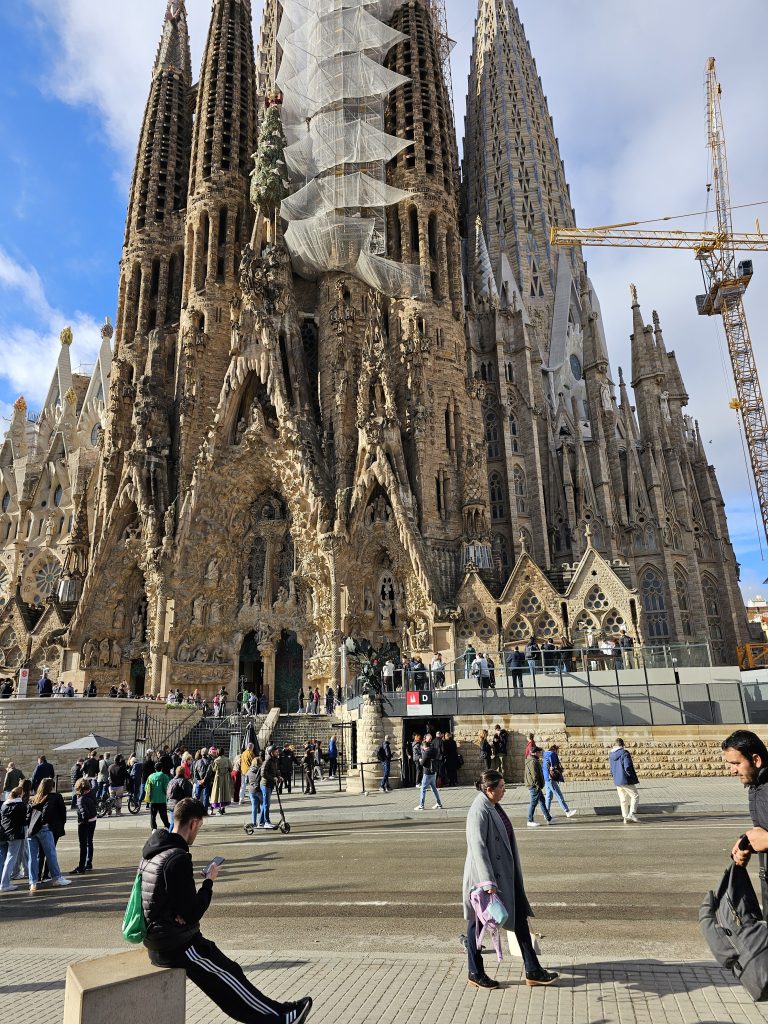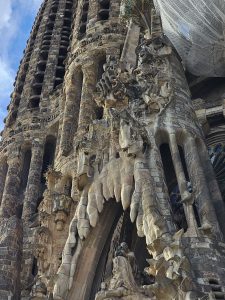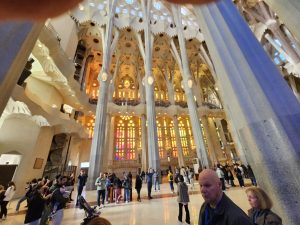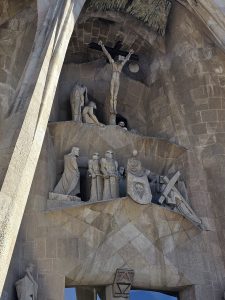
Pictures on the Barcelona Pictures page.
Getting to the Barcelona airport from Florence on Thursday was easy. Getting from the airport to our hotel took a long time. It is only about 10 miles, but traffic was stop and go for nearly the whole trip. It took nearly an hour and some of the areas we went through were not the most salubrious. The map had not given me much of an idea of the area around the hotel and I did not realize how crowded things were. We are surrounded by shops, large and small. We are near the Cathedral de Barcelona, which in my memory had become conflated with Familia Sagrada from our visit 20+ years ago.
The hotel is relatively small and quite comfortable. There are plenty of places to walk to in the surrounding area. It boasts a rooftop terrace on the 7th floor with views of the surrounding area. We went up there for a drink and tapas at about 8:00 pm and just about froze. It was cold and windy.
We had a tour of Sagrada Familia (Holy Family) basilica scheduled for 10:00 and were advised to get there no later than 9:30. It was good advice, because it was more difficult to get through their security than some airport security. The taxi ride from the hotel through the morning traffic took a long time which the driver said was normal. Seeing how far away Sagrada Familia was, I realized that the Gothic cathedral I went to the last time could not possibly have been Sagrada Familia. For one thing, it is nothing like any Gothic church I have ever seen.
The guide assigned to our group of English speakers was really informative and pleasant. Monica knew not only the “hard facts” like dimensions and dates, but she also understood the symbolism of what Goudi has / had architected. Sagrada Familia has been under construction since the 1880s and, like medieval cathedrals, probably has at least 100 years more before it is finished. Gaudi spent the last 43 years of his life working on the basilica, and the last 15, working on it exclusively, even sleeping in the workshop to be close to the site. He knew that he would not live to see it completed, and he trained the next generation of architects to understand what he was trying to accomplish so they could carry on the work.
Everything about the Sagrada Familia basilica seems to have a symbolic meaning, from the number of towers (18) to the colors of the stained glass windows, to the shapes of the supporting columns. As a side note, although the church was originally conceived as a Gothic-style church, there are no exterior buttresses because of the way Gaudi designed the supporting columns to spread the weight of the roof and towers.

Our tour started outside the church, where Monica pointed out the various towers (completed, under construction, and not yet begun). She then carefully pointed out the “decorations” (I don’t have a better word) on the front of the church. When I first looked at them, I thought is was a jumble of designs, statues, and lines, but she pointed out groupings and a hierarchy of groupings which made sense.

The interior space of the church is intended to be lit, as much as possible, by the external light. The space is open and two sides are nearly all stained glass. There were a bazillion people inside (conservative estimate) but it did not feel particularly crowded. Even the stained glass panels have symbolic meaning: they are labeled with the names of places from around the world as a way to show the “inclusion” of Catholicism.
As Monica tells it, the longer Gaudi worked on the project, the more he changed and those changes impacted the design. It became increasingly important for him to insure that the design be carried out following his principles. That did not mean rigid adherence to details, but to the overall spirit of the design.

We finished the tour on the other side of the church. If the east side, where we entered, represented light and life, the west side, where we exited, represented the Passion and hope. The west façade, this time with less symbolism, shows what I would call the events of Holy Week. [Semana Santa is a big deal in Spain.] The images here are more representative than abstract.
We had an interesting ride back to [almost] the hotel. Our driver wanted to practice his English and I always want to try my Spanish. We discovered that he was going to Jerez in August and he was surprised when I knew which festival he would attend. We agreed that is very hot then. He wanted to know if there were taxis in Santa Fe and we talked about the curse of Uber and Lyft. He said that there are no Ubers in Catalonia. [Barcelona]. When we had been driving for about 20 minutes, he showed me his map with backed up traffic and a time estimate of 25 minutes. He said “You walk. 10 minutes. Go there!” So we did. Two minor direction changes—due to bad Google map directions, I am sure—and we were back in the area of the hotel.
The forecast for Friday was for clouds and rain, but for most of the day it was clear and windy. In fact, at Sagrada Familia, the reflected sunlight was near blinding and my sunglasses helped hardly at all. Since was nice out we explored the area near the hotel. Our nominal destination was a place for churros y chocolate, but we were just out walking. The 8th was Day of the Women (Dia de Mujeres) and we encountered a good sized march of women, mostly young, carrying protest signs. We did find a churros place which also served gelato, so both of us had a treat.
Then we walked in the direction of the hotel where we ran into [figuratively] the strong police presence associated with the march. On the Plaça Nova, near the Cathedral de Barcelona, there were many buskers, cafés, and families enjoying to brisk weather.